Effects of Granular Gradation on the Compressibility and Permeability of Lime-Stabilized Slurry with High Water Content
Abstract
1. Introduction
2. Materials and Methods
2.1. Test Materials
2.2. Test Protocols and Devices
3. Results and Analysis
3.1. Compressibility of Lime-Stabilized Slurry
3.2. Permeability of Lime-Stabilized Slurry
3.3. Microstructure of Lime-Stabilized Slurry
3.3.1. MIP Test Results
3.3.2. SEM Test Results
4. Discussion
5. Conclusions
- (1)
- Lime-stabilized slurry with high water content showed obvious evidence of remolded yield stress, which increased with the increase in lime dosage. Meanwhile, it was established that lime increased the permeability of the slurry with high water content, but that its permeability did not rise infinitely with the increase in lime dosage, while the permeability of the stabilized slurry decreased once the lime dosage exceeded a certain threshold value.
- (2)
- The granular gradation affected the lime stabilization impact on the slurry with high water content, where clay proved more sensitive to lime stabilization than silt. When the lime dosage was 1%, the remolded yield stress of the stabilized slurry gradually rose with increased clay content, while its compressibility gradually decreased and permeability gradually improved.
- (3)
- The mixing of lime and slurry induced the flocculation of fine particles into flocs through ion exchange, forming a relatively stable soil structure and generating further bonding under the volcanic ash reaction, thus augmenting the remolded yield stress of the stabilized slurry. The pore volume and diameters also increased as part of this process, thus enhancing the permeability of the stabilized slurry.
- (4)
- For the slurry with high clay content, the recommended lime dosage to reduce its compressibility or enhance its permeability was 2%, whereas for the slurry with high silt content, it was 3%.
Author Contributions
Funding
Institutional Review Board Statement
Informed Consent Statement
Data Availability Statement
Conflicts of Interest
References
- Fytili, D.; Zabaniotou, A. Utilization of sewage sludge in EU application of old and new methods—A review. Renew. Sustain. Energy Rev. 2008, 12, 116–140. [Google Scholar] [CrossRef]
- Tang, Y.X.; Miyazaki, Y.; Tsuchida, T. Practices of reused dredging by cement treatment. Soils Found. 2001, 41, 129–143. [Google Scholar] [CrossRef] [PubMed]
- Zhang, N.; Zhu, W.; He, H. Experimental study on settling velocity of soil particles in dredged slurry. Mar. Georesources Geotechnol. 2017, 35, 747–757. [Google Scholar] [CrossRef]
- Kasmi, A.; Abriak, N.E.; Benzerzour, M. Effect of dewatering by the addition of flocculation aid on treated river sediments for valorization in road construction. Waste Biomass Valorization 2017, 8, 585–597. [Google Scholar] [CrossRef]
- Wang, W.; Luo, Y.; Qiao, W. Possible solutions for sludge dewatering in China. Front. Environ. Sci. Eng. China 2010, 4, 102–107. [Google Scholar] [CrossRef]
- Kang, G.; Tsuchida, T.; Athapaththu, A.M.R.G. Engineering behavior of cement-treated marine dredged clay during early and later stages of curing. Eng. Geol. 2016, 209, 163–174. [Google Scholar] [CrossRef]
- Abiodun, A.A.; Nalbantoglu, Z. Lime pile techniques for the improvement of clay soils. Can. Geotech. J. 2014, 52, 760–768. [Google Scholar] [CrossRef]
- Di Sante, M.; Fratalocchi, E.; Mazzieri, F.; Brianzoni, V. Influence of delayed compaction on the compressibility and hydraulic conductivity of soil–lime mixtures. Eng. Geol. 2015, 185, 131–138. [Google Scholar] [CrossRef]
- Bhattacharya, P.G. Fatigue test set-up for lime soil mixtures. J. Inst. Eng. 1987, 68, 130–135. [Google Scholar]
- Puppala, A.J.; Mohammad, L.N.; Allen, A. Engineering behavior of lime-treated Louisiana subgrade soil. Transp. Res. Rec. J. Transp. Res. Board 1996, 1546, 24–31. [Google Scholar] [CrossRef]
- Ranganatham, B.V. Soil structure and consolidation characteristics of black cotton clay. Géotechnique 1961, 11, 333–338. [Google Scholar] [CrossRef]
- Diamond, S.; Kinter, E. Mechanism of soil-lime stabilization. Highw. Res. Rec. 1965, 92, 83–102. [Google Scholar]
- Jha, A.K.; Sivapullaiah, P. Mechanism of improvement in the strength and volume change behavior of lime stabilized soil. Eng. Geol. 2015, 198, 53–64. [Google Scholar] [CrossRef]
- Di Sante, M.; Fratalocchi, E.; Mazzieri, F.; Pasqualini, E. Time of reactions in a lime treated clayey soil and influence of curing conditions on its microstructure and behavior. Appl. Clay Sci. 2014, 99, 100–109. [Google Scholar] [CrossRef]
- Nalbantoglu, Z.; Tuncer, E.R. Compressibility and hydraulic conductivity of a chemically treated expansive clay. Can. Geotech. J. 2001, 38, 154–160. [Google Scholar] [CrossRef]
- Sudhakar, M.; Shivananda, P. Compressibility behavior of lime-stabilized clay. Geotech. Geol. Eng. 2005, 23, 309–319. [Google Scholar]
- Wang, Y.J.; Cui, A.M.; Tang, N. Effects of aggregate size on the compressibility and air permeability of lime-treated fine-grained soil. Eng. Geol. 2012, 228, 167–172. [Google Scholar] [CrossRef]
- Nagih, M.; El-Rawi, A.; Awad, A. Permeability of lime stabilized Soils. Transp. Eng. J. ASCE 1981, 107, 25–35. [Google Scholar]
- Locat, J.; Trembaly, H.; Leroueil, S. Mechanical and hydraulic behavior of a soft inorganic clay treated with lime. Can. Geotech. J. 1996, 33, 654–669. [Google Scholar] [CrossRef]
- Quang, N.D.; Chai, J.C. Permeability of lime- and cement-treated clayey soils. Can. Geotech. J. 2015, 52, 1221–1227. [Google Scholar] [CrossRef]
- Cuisinier, O.; Auriol, J.C.; Le Borgne, T.; Deneele, D. Microstructure and hydraulic conductivity of a compacted lime-treated soil. Eng. Geol. 2011, 123, 187–193. [Google Scholar] [CrossRef]
- Al-Mukhtar, M.; Khattab, S.; Alcover, J.F. Microstructure and geotechnical properties of lime-treated expansive clayey soil. Eng. Geol. 2012, 139, 17–27. [Google Scholar] [CrossRef]
- Ministry of Water Resources and Electricity Standard for Soil Test Method; China Planning Press: Beijing, China, 1989.
- Hong, Z.S.; Yin, J.; Cui, Y.J. Compression behavior of reconstituted soils at high initial water contents. Géotechnique 2010, 60, 691–700. [Google Scholar] [CrossRef]
- Zhang, X.W.; Kong, L.W.; Guo, A.G.; Tuo, Y.F. Evolution of microscopic pore of structured clay in compression process based on SEM and MIP test. Chin. J. Rock Mech. Eng. 2012, 31, 406–412. [Google Scholar]
- Butterfield, R. A natural compression law for soils. Géotechnique 1979, 29, 469–480. [Google Scholar] [CrossRef]
- Drnevich, V.P.; Jose, B.T.; Sridharan, A. Log-Log method for determination of pre-consolidation pressure. Geotech. Test. J. 1989, 12, 8. [Google Scholar]
- Liang, C.Y.; Wu, Y.D.; Liu, J. Influences of arrangement and cementation of soil particles on structure of artificial structural soil. Chin. J. Geotech. Eng. 2022, 44, 2135–2142. [Google Scholar]
- Kurochkina, G.N.; Pinskii, D.L. Development of a mineralogical matrix at the adsorption of polyelectrolytes on soil minerals and soils. Eurasian Soil Sci. 2012, 45, 1057–1067. [Google Scholar] [CrossRef]
- Zhuang, X.S.; Yu, X.Y. Experimental study on strength of expansive soil treated by lime-basalt fiber. China Civ. Eng. J. 2015, 48, 166–170. [Google Scholar]
- Song, L.H.; Mei, G.X.; Zhai, J.M. Analysis of the effect of pores on the permeability of clay. In Proceedings of the 10th Academic Conference on Geomechanics and Geotechnical Engineering of the Chinese Civil Engineering Society, Noordwijk, The Netherlands, 13–15 June 2007; pp. 481–485. [Google Scholar]
- Tran, T.D.; Cui, Y.J.; Tang, A.M.; Audiguier, M.; Cojean, R. Effects of lime treatment on the microstructure and hydraulic conductivity of Héricourt clay. J. Rock Mech. Geotech. Eng. 2014, 6, 399–404. [Google Scholar] [CrossRef]
- Zhao, H.; Liu, J.; Guo, J. Reexamination of lime stabilization mechanism of expansive clay. J. Mater. Civ. Eng. 2015, 27, 895–902. [Google Scholar] [CrossRef]
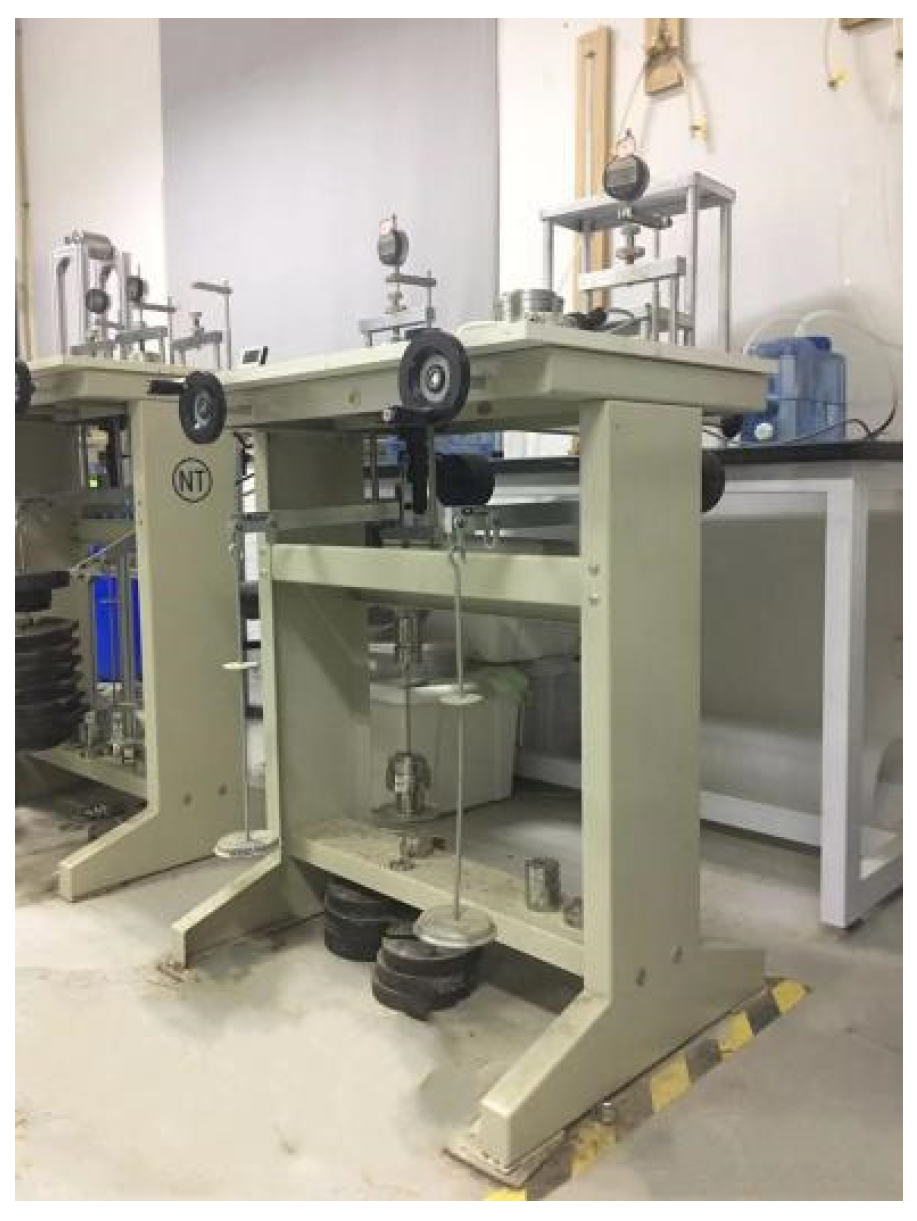

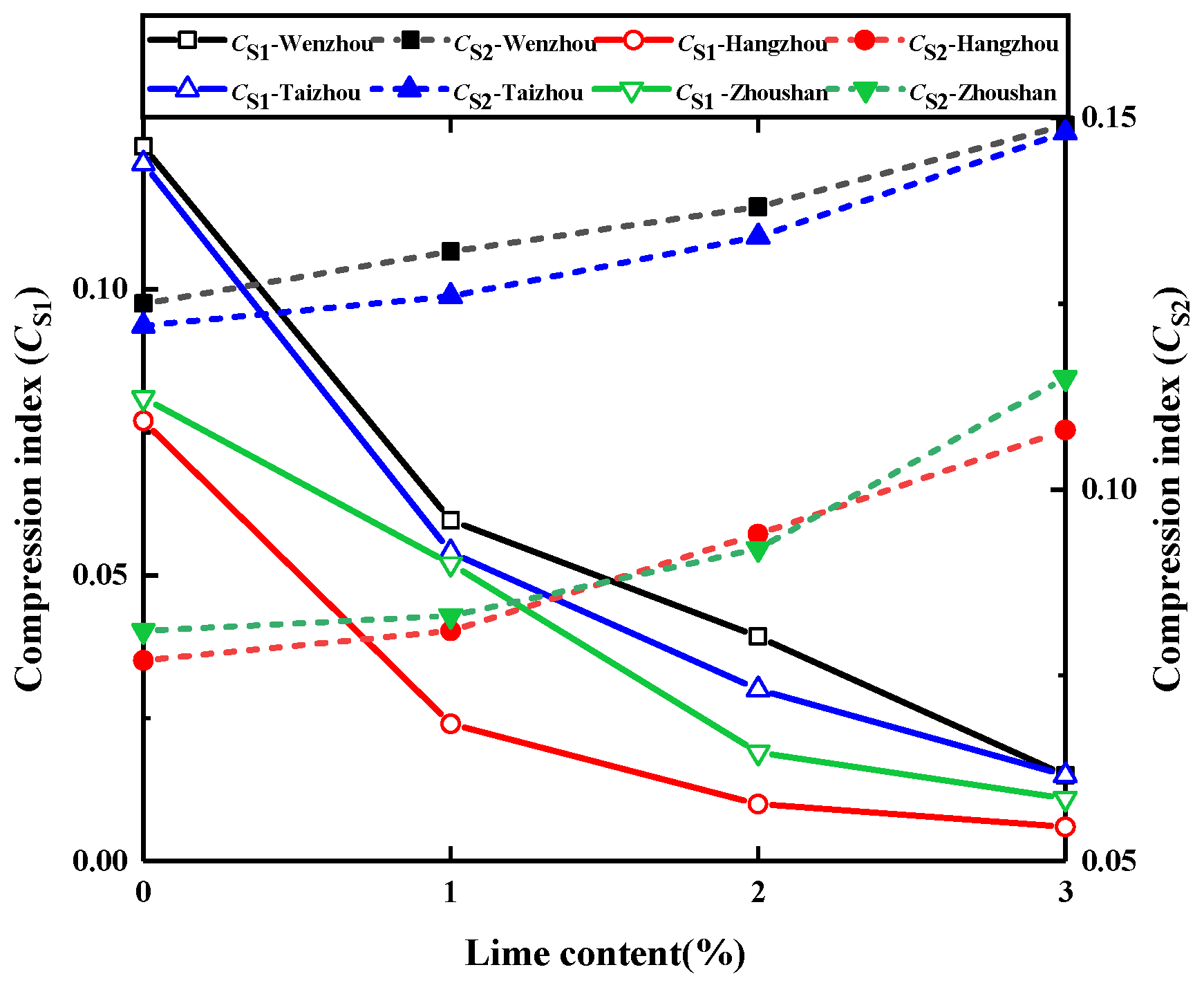

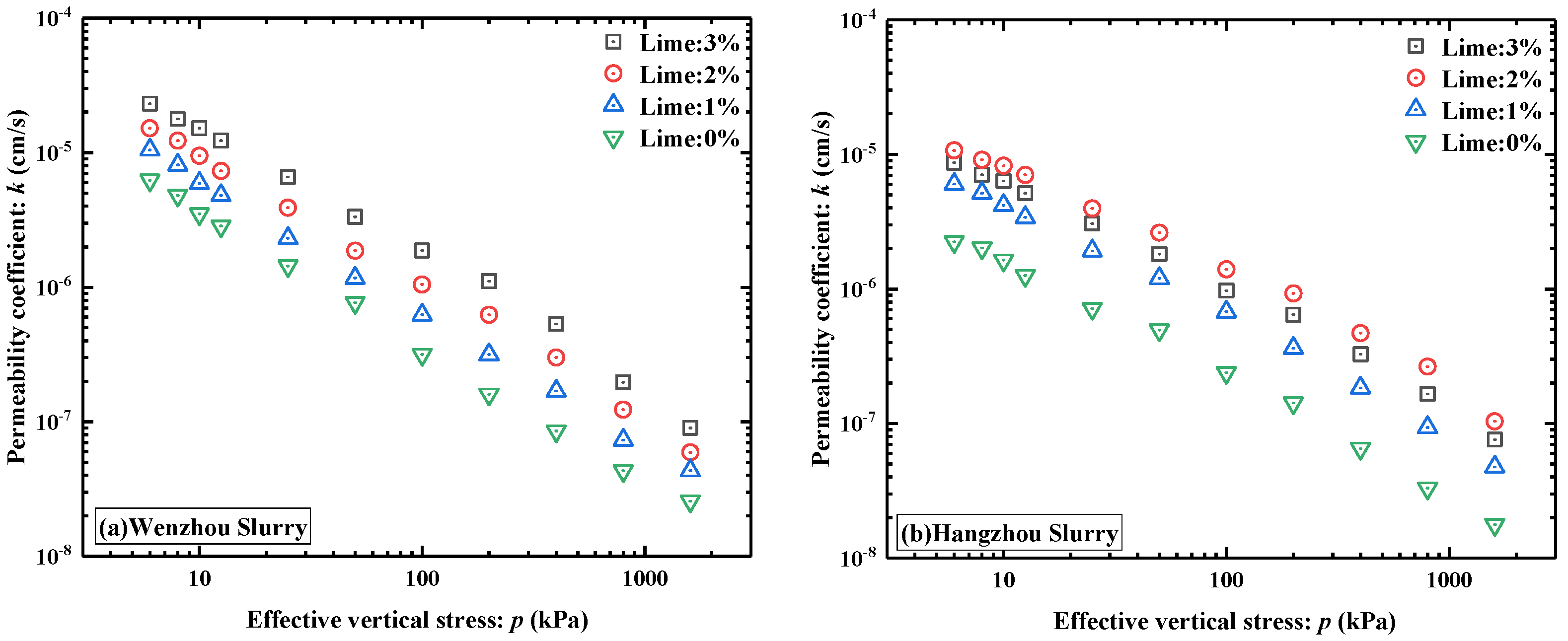
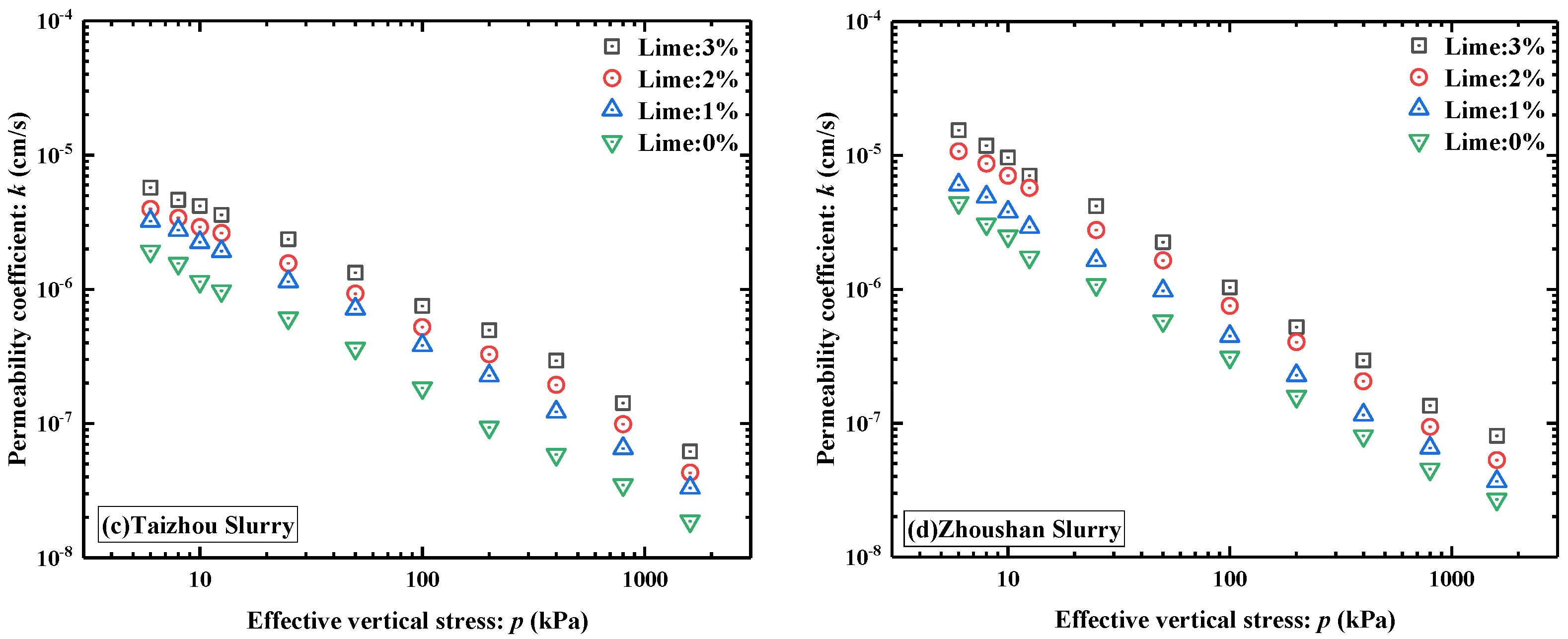
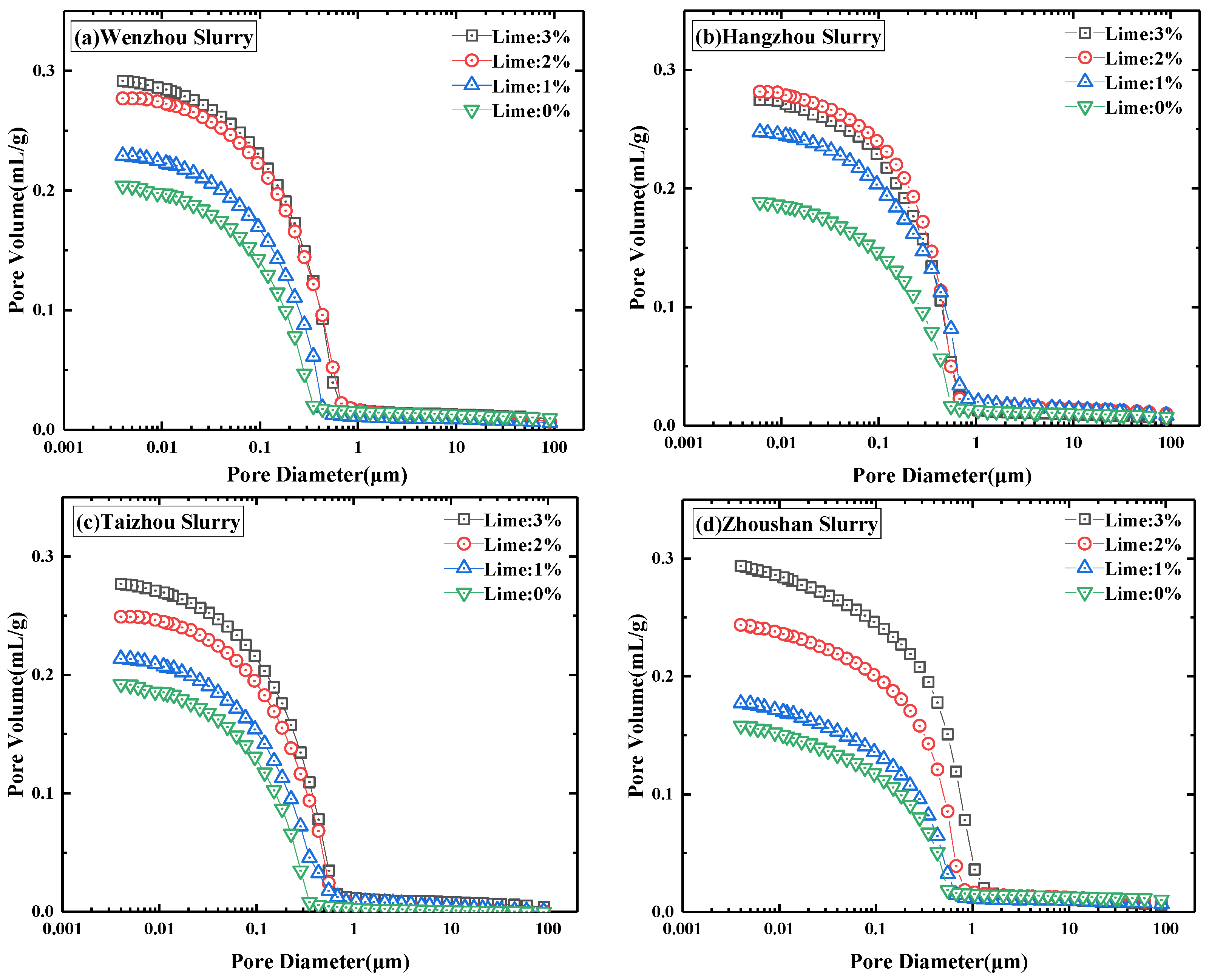

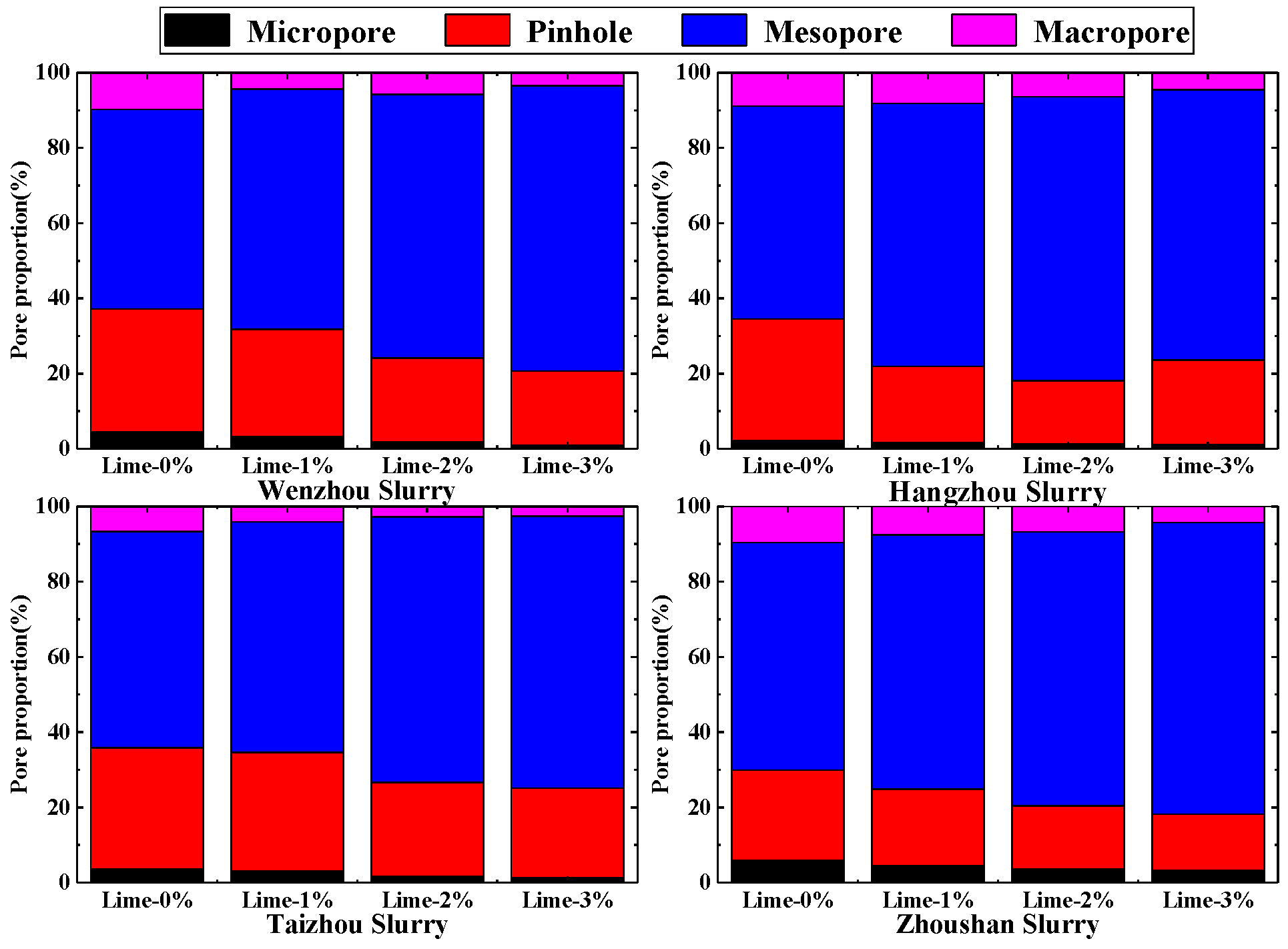
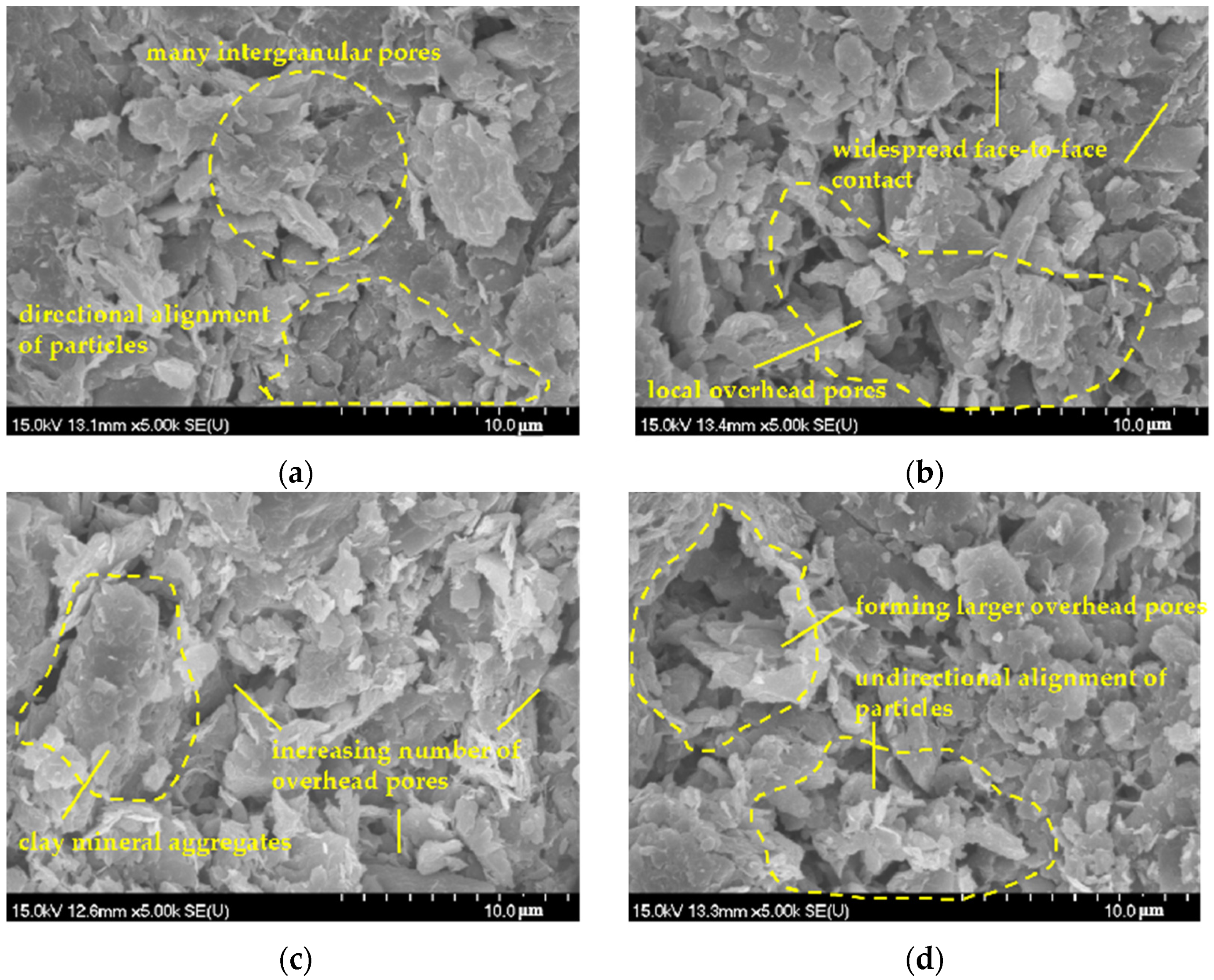
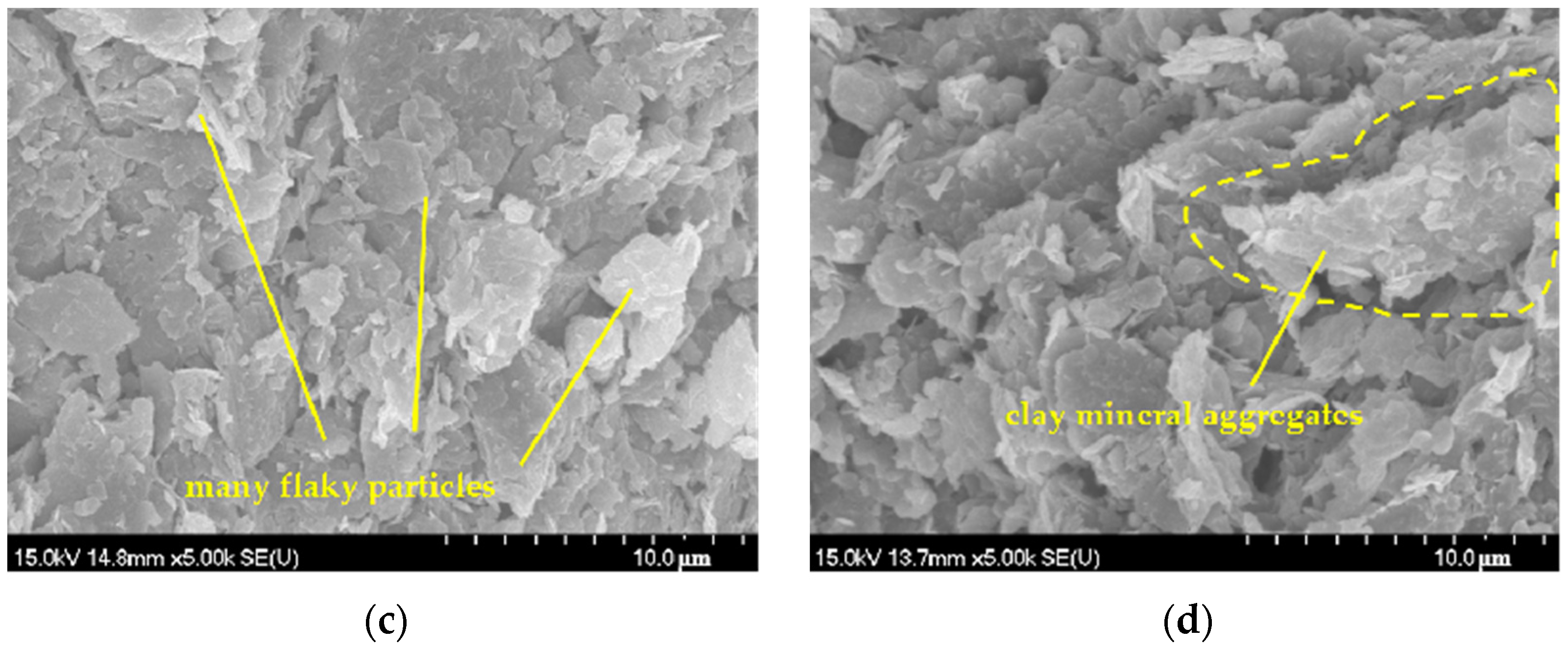
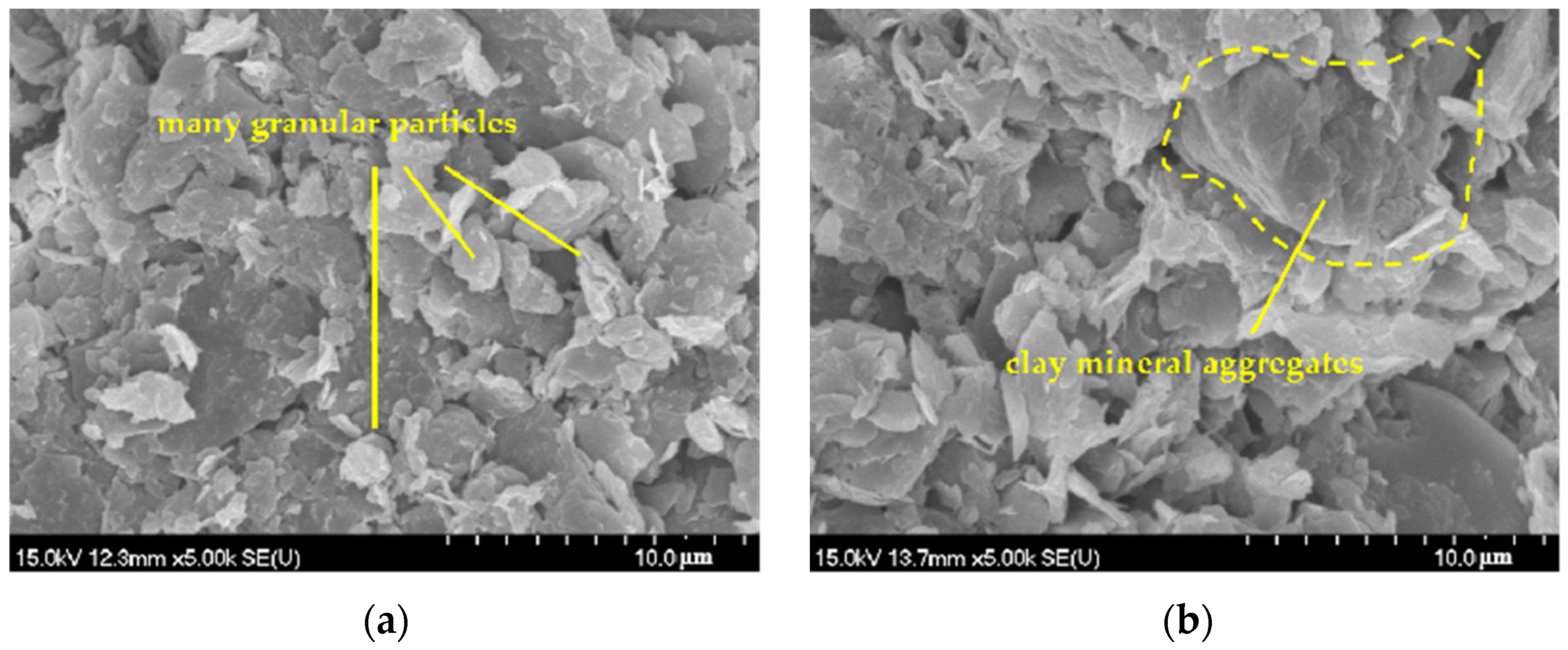
| Sampling Site | Wenzhou | Taizhou | Zhoushan | Hangzhou | |
|---|---|---|---|---|---|
| Initial water content w0 (%) | 104 | 122 | 94 | 90 | |
| Liquid limit wL (%) | 56 | 40 | 31 | 38 | |
| Plastic limit wP (%) | 32 | 27 | 18 | 27 | |
| Relative density GS | 2.55 | 2.63 | 2.72 | 2.62 | |
| Plastic index IP | 24 | 13 | 15 | 11 | |
| Granular gradation | <0.002 mm | 2 | 2.5 | 23.1 | 25.9 |
| 0.002–0.075 mm | 54.7 | 66.1 | 32.5 | 60.7 | |
| 0.075–0.425 mm | 43.2 | 25.3 | 41.8 | 13.4 | |
| 0.425–0.2 mm | 0.1 | 6.1 | 2.6 | 0 | |
| Soil Type | Initial Water Content w0 (%) | Liquid Limit wL (%) | Lime Dosage (%) |
|---|---|---|---|
| Wenzhou | 168 | 56 | 0, 1, 2, and 3 |
| Hangzhou | 114 | 38 | 0, 1, 2, and 3 |
| Taizhou | 120 | 40 | 0, 1, 2, and 3 |
| Zhoushan | 93 | 31 | 0, 1, 2, and 3 |
Disclaimer/Publisher’s Note: The statements, opinions and data contained in all publications are solely those of the individual author(s) and contributor(s) and not of MDPI and/or the editor(s). MDPI and/or the editor(s) disclaim responsibility for any injury to people or property resulting from any ideas, methods, instructions or products referred to in the content. |
© 2023 by the authors. Licensee MDPI, Basel, Switzerland. This article is an open access article distributed under the terms and conditions of the Creative Commons Attribution (CC BY) license (https://creativecommons.org/licenses/by/4.0/).
Share and Cite
Weng, Z.; Zheng, Y.; Zhu, Q.; Sun, H.; Ni, D. Effects of Granular Gradation on the Compressibility and Permeability of Lime-Stabilized Slurry with High Water Content. Appl. Sci. 2023, 13, 4101. https://doi.org/10.3390/app13074101
Weng Z, Zheng Y, Zhu Q, Sun H, Ni D. Effects of Granular Gradation on the Compressibility and Permeability of Lime-Stabilized Slurry with High Water Content. Applied Sciences. 2023; 13(7):4101. https://doi.org/10.3390/app13074101
Chicago/Turabian StyleWeng, Zhenqi, Yueyue Zheng, Qinhao Zhu, Honglei Sun, and Dingyu Ni. 2023. "Effects of Granular Gradation on the Compressibility and Permeability of Lime-Stabilized Slurry with High Water Content" Applied Sciences 13, no. 7: 4101. https://doi.org/10.3390/app13074101
APA StyleWeng, Z., Zheng, Y., Zhu, Q., Sun, H., & Ni, D. (2023). Effects of Granular Gradation on the Compressibility and Permeability of Lime-Stabilized Slurry with High Water Content. Applied Sciences, 13(7), 4101. https://doi.org/10.3390/app13074101






